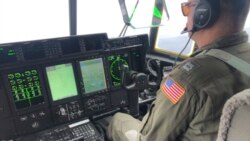ລະຫວ່າງແຫຼມໃຕ້ສຸດຂອງ ສະຫະລັດ ແລະ ຄິວບາ ເປັນແລວຂອງສາຍນໍ້າທີ່ຮ້ອງວ່າ ຊ່ອງແຄບຟລໍຣິດາ. ພາຫະນະລາດຕະເວນຂອງໜ່ວຍຍາມຝັ່ງທາງທະເລຫຼາຍລໍາ ໄດ້ທໍາການລາດຕະເວນຢູ່ເຂດນ່ານນ້ຳເຫຼົ່ານີ້ໃນທຸກໆມື້, ເພື່ອຊອກຫາຜູ້ຍົກຍ້າຍຖິ່ນຖານທີ່ພະຍາຍາມເຂົ້າມາໃນ ສະຫະລັດ ຢ່າງຜິດກົດໝາຍ. ໃນຕົ້ນປີນີ້, VOA ໄດ້ຂີ່ຖ້ຽວບິນພິເສດກັບໜ່ວຍຍາມຝັ່ງ ສະຫະລັດ ໃນການດໍາເນີນງານລາດຕະເວນ.
ມາກັບພວກເຮົາ, ໃນຂະນະທີ່ພວກເຮົາກໍາລັງບິນອອກຈາກສະໜາມບິນສາກົນ ຄີແວັສ (Key West).
ນີ້ບໍ່ແມ່ນການເດີນທາງໄປຍັງປາຍທາງ, ແຕ່ເພື່ອຢຸດຄົນອື່ນໆຈາກການໄປເຖິງບໍລິເວນນັ້ນ.
ໜ່ວຍຍາມຝັ່ງ ສະຫະລັດ, ຈະລາດຕະເວນໃນເຂດນ່ານນໍ້າ ລະຫວ່າງ Key West ແລະ ຄິວບາ. ພວກເຂົາເຈົ້າຊອກຫາຜູ້ຍົກຍ້າຍຖິ່ນຖານຢູ່ໃນເຮືອທີ່ບໍ່ມີຄວາມປອດໄພ, ເຊິ່ງພະຍາຍາມເຂົ້າມາໃນ ສະຫະລັດ ຢ່າງຜິດກົດຫມາຍ.
VOA ໄດ້ຮັບການເຂົ້າເຖິງແບບພິເສດ ໃນການບິນກັບບັນດາລູກເຮືອຢູ່ໃນເຮືອບິນເຝົ້າລະວັງ HC-144.
ຢູ່ຈຸດທີ່ແຄບທີ່ສຸດ, ເຊິ່ງເປັນຊ່ອງແຄບຟລໍຣິດາທີ່ມີຄວາມກວ້າງ 150 ກິໂລແມັດ ແລະ ເລິກ 1,800 ແມັດ.
ພັນໂທ ອິເຈ ຄຸນນິງແຮມ (Lt. E.J. Cunningham), ນັກບິນໜ່ວຍຍາມຝັ່ງຂອງສະຫະລັດ ກ່າວວ່າ:
“ພວກເຮົາຮູ້ສຶກວ່າ ພວກເຂົາເຈົ້າຢູ່ໃນເຮືອທີ່ມີຂະຫນາດນ້ອຍ, ຢູ່ບໍລິເວນນີ້ໃນນ່ານນ້ໍາທີ່ເປັນອັນຕະລາຍນີ້. ຂ້າພະເຈົ້າເຂົ້າໃຈວ່າພວກເຂົາພະຍາຍາມເຂົ້າມາໃນ ສະຫະລັດ, ແຕ່ພວກເຮົາຕ້ອງເຮັດໃຫ້ໝັ້ນໃຈວ່າ ພວກເຂົາໄດ້ຮັບຄວາມປອດໄພ.”
ຄາໂຣລີນ ພຣີສຸດທີ, ນັກຂ່າວ VOA ກ່າວວ່າ:
“ສິ່ງທີ່ພວກເຂົາກໍາລັງຊອກຫາ ແມ່ນເນື້ອໃນທີ່ເປັນເອກະລັກ, ບາງສິ່ງທີ່ແຕກຕ່າງຢ່າງຫຼວງຫຼາຍກ່ວາການເດີນທາງໄປຫາປາ ຫຼືການລ່ອງເຮືອທ່ອງທ່ຽວແບບຄອບຄົວ, ບາງສິ່ງທີ່ເບິ່ງຄືວ່າ ເປັນເຮືອບ້ານໆຫຼາຍ.”
ພັນໂທ ອິເຈ ຄຸນນິງແຮມ ກ່າວວ່າ:
“ພວກເຮົາມີເຮືອລຳນຶ່ງທີ່ເປັນພຽງແຜ່ນໄມ້ມັດດ້ວຍເຊືອກ ພ້ອມດ້ວຍກະຖັງຈໍານວນນຶ່ງເຂົ້າກັນ.”
ໜ່ວຍຍາມຝັ່ງ ໄດ້ຍຶດເຮືອທີ່ເຮັດແບບພື້ນຖານອີກລຳນຶ່ງຢູ່ນອກເຂດນ່ານນ້ຳໃນດິນແດນຂອງ ຄິວບາ.
ທ່ານເບຣນ ວີລລິສ (Blaine Willis), ຊ່າງເຕັກນິກໄຟຟ້າຂອງໜ່ວຍຍາມຝັ່ງສະຫະລັດ ກ່າວວ່າ:
“ພວກເຮົາມີການຕິດຕໍ່ກັບຣາດ້າ, ດັ່ງນັ້ນ ພວກເຮົາຈຶ່ງໄດ້ໄປເບິ່ງມັນ ແລະ, ແນ່ນອນທີ່ສຸດ, ມັນແມ່ນເຮືອແພຢາງສູບລົມບັນທຸກສອງຄົນ ທີ່ມີພັດລົມເທິງດ້ານຫຼັງ ແລະທັງສອງກໍຖືມັນໄວ້ເປັນເຄື່ອງຈັກ.”
ຊ່າງເຕັກນິກຄື ທ່ານ ວິລລິສ ເຫັນເຮືອຢູ່ໃນຣາດ້າພິເສດຂອງພວກເຂົາເຈົ້າ ແລະເຊັນເຊີອິນຟາເລດໃນຕອນກາງຄືນ, ເຊິ່ງພວກເຮົາບໍ່ສາມາດສະແດງໃຫ້ພວກທ່ານເຫັນໄດ້ ເນື່ອງຈາກຄວາມກັງວົນດ້ານຄວາມປອດໄພ.
ລູກເຮືອ ກວດພົບກັບບາງສິ່ງທີ່ເບິ່ງແບບແປກປະຫຼາດ.
ເຮືອບິນໄດ້ບິນວົນກັບ ແລະບິນເຂົ້າໄປຢ່າງໄວວາເພື່ອເບິ່ງມັນໃກ້ໆ. ບາງຄັ້ງຜູ້ໂດຍສານ ກໍ່ເຮັດໃຫ້ຕົນເອງຖືກພົບເຫັນ.
ທ່ານໂຣເບິດ ເດບ (Robert Depe), ຊ່າງເຕັກນິກບໍາລຸງຮັກສາຂອງ USCG ກ່າວວ່າ:
“ພວກເຂົາພຽງແຕ່ພະຍາຍາຈະຫຼີກລ້ຽງພວກເຮົາ. ພວກເຂົາໝຸດລົງ, ພະຍາຍາມລີ້ໂຕພວກເຂົາ, ພະຍາຍາມປົກຄຸມຕົນເອງດ້ວຍຜ້າໃບກັນນໍ້າ. ໃນບາງຄັ້ງ, ເປັນພຽງແຕ່ວ່າພວກເຂົາຢູ່ທີ່ນັ້ນ, ບາງຄັ້ງ ພວກເຂົາຊີ້ມາທາງພວກເຮົາ ແລະພະຍາຍາມສະແດງໃຫ້ພວກເຮົາເຫັນ, ແລ້ວກ່າວວ່າ ‘ຫັ້ນເດ, ພວກເຂົາຢູ່ທີ່ນັ້ນ. ເຂົາເຈົ້າສາມາດເຫັນພວກເຮົາແລ້ວ’”.
ອັນນີ້, ແລະການມອງເຫັນອື່ນໆອີກ ກໍບໍ່ມີຫຍັງໜ້າເປັນຫ່ວງ. ຖ້າມັນມີສິ່ງທີ່ໜ້າເປັນຫ່ວງ, ນັກບິນກໍຈະວິທະຍຸຫາໃຜຜູ້ນຶ່ງຢູ່ເທິງໜ້ານ້ໍານັ້ນ.
“ໃນຈຸດນັ້ນ, ພວກເຮົາມີຄົນຫຼາຍຢູ່ທີ່ນີ້ ທີ່ພະຍາຍາມຊອກຫາເປົ້າຫມາຍດັ່ງກ່າວນັ້ນ.”
ພັນໂທ ຊາມູເອລ ກຣາໂກວເວີ (Lt. Samuel Krakower), ຜູ້ບັນຊາການກຳປັ່ນ Raymond Evans, ເຊິ່ງເປັນນຶ່ງໃນຈໍານວນເຮືອລາດຕະເວນ ສໍາລັບຊອກຫາຜູ້ຍົກຍ້າຍຖິ່ນຖານຢູ່ໃນຊ່ອງແຄບຟລໍຣິດາ.
ເຮືອບິນ ໄດ້ບອກໃຫ້ເຮືອລາດຕະເວນໄປຂົງເຂດທີ່ແນ່ນອນ ແລະກໍໄດ້ນຳເອົາຜູ້ຄົນຂຶ້ນມາເທິງເຮືອ.
“ຜູ້ຍົກຍ້າຍຖິ່ນຖານທຸກໆຄົນ ໄດ້ຮັບຜ້າຫົ່ມນຶ່ງຜືນ.”
ໃນຄືນນຶ່ງ, ເທິງຊັ້ນດາດຟ້າແຫ່ງນີ້ ມີຊາວຄິວບາຫຼາຍກວ່ານຶ່ງຮ້ອຍຄົນ ຜູ້ທີ່ໄດ້ຢູ່ເທິງເຮືອເປັນເວລາຫຼາຍມື້ ສຳລັບການເກັບກຳຂໍ້ມູນ. ຄົນສ່ວນໃຫຍ່ແມ່ນຖືກສົ່ງກັບຄືນໄປປະເທດຄິວບາ.
ພັນໂທ ຊາມູເອລ ກຣາໂກວເວີ, ຜູ້ບັນຊາການກໍາປັ່ນ Raymond Evans ແຫ່ງ USCGC ກ່າວວ່າ:
“ເປັນຄືນທີ່ອິດເມື່ອຍຫຼາຍ, ແຕ່ແນ່ນອນ, ເຮືອບາງລໍາເຫຼົ່ານັ້ນ ໄດ້ຈົມລົງຢ່າງໄວວາ ແລະມັນກໍເປັນໂອກາດທີ່ຈະ... ມັນແມ່ນການຄົ້ນຫາ ແລະກູ້ໄພແທ້ໆຢູ່ໃນຈຸດນັ້ນ.”
ທ່ານ ກຣາໂກວເວີ ຍັງລາດຕະເວນຢູ່ເຂດນ່ານນ້ຳເພື່ອຊອກຫາກຳປັ່ນຂອງຊາວເຮຕີນໍາອີກດ້ວຍ, ເຊິ່ງທ່ານກ່າວວ່າ:
“ໃນຄວາມເປັນຈິງແລ້ວ ເຮືອລາດຕະເວນຂອງພວກເຮົາໄດ້ຂັດຂວາງອີກຈໍານວນ 94 ຄົນໃນເຮືອລໍານຶ່ງ. ສະນັ້ນ, ຕົວເລກແມ່ນມີຫຼາຍກວ່າເມື່ອເວົ້າເຖິງເຮືອລຳນຶ່ງໃນເຮຕີ ທີ່ປົກກະຕິແລ້ວອາດຈະເຫັນແຕ່ຈໍານວນ 20 ຫຼື 30 ຄົນໃນເຮືອແພຂອງຄິວບາ.”
ໃນປີແລ້ວນີ້, ມີຊາວເຮຕີ 1,800 ຄົນ ແລະ ຊາວຄິວບາອີກຫຼາຍກວ່າ 6,600 ຄົນ ຖືກສົ່ງກັບຄືນປະເທດ.
ທັງທາງທະເລ ແລະ ທາງອາກາດ, ການມອງເຫັນສິ່ງທີ່ເກີດຂຶ້ນແບບຜ່ານໆ, ກໍເປັນການສ້າງຄວາມດຸ່ນດ່ຽງດ້ານຄວາມປອດໄພໃຫ້ແກ່ກົດໝາຍກ່ຽວກັບຊາຍແດນ.
ອ່ານບົດລາຍງານດ້ານລຸ່ມນີ້ເປັນພາສາອັງກິດ
Between the southernmost tip of the United States and Cuba lies a body of water called the Florida Straits. Coast Guard vehicles patrol these waters daily, looking for migrants illegally trying to enter the U.S. VOA earlier this year got an exclusive flight with the U.S. Coast Guard on patrol. VOA’s Senior Washington Correspondent Carolyn Presutti takes us along on the ride.
Come with us --- as we take off from Key West International Airport.
Not to go to a destination. But to stop others from getting there.
The U.S. Coast Guard patrols the waters between Key West and Cuba. They search for migrants in unsafe vessels, trying to enter the U.S. illegally.
VOA was given exclusive access to fly with the crew on this HC-144 surveillance plane.
At its narrowest point, the Florida Straits are 150 kilometers wide and 1,800 meters deep.
Lt. E.J. Cunningham, US Coast Guard
“We feel they are in small watercraft, out here in dangerous waters. I understand they are trying to get to the U.S., but we have to make sure they are being safe.”
Carolyn Presutti, VOA News
"What they’re looking for is a unique profile, something entirely different than a fishing expedition or a family cruise – something that looks like a very rustic vessel."
Lt. E.J. Cunningham, US Coast Guard Pilot
"We had one watercraft that was just a bunch of wood planks held together by like ropes and some barrels together."
The Coast Guard seized another homemade boat just outside Cuban territorial waters.
Blaine Willis, US Coast Guard Electrical Tech
“We had a radar contact, so we went to go look at it and, sure enough, it was an inflatable two-person raft that had a weed eater off the back of it that the guy was holding on to as a motor.”
Technicians like Willis see the watercraft on their specialized radar and nighttime infrared sensors – which we can’t show you due to security concerns.
The crew detects something peculiar.
The plane circles back and swoops in for a closer look. Sometimes the passengers give themselves away.
Robert Depe, USCG Maintenance Tech
“They’re trying to just avoid us. They duck down, try to hide themselves, try to cover themselves with a tarp. Other times, it’s just they are there, sometimes they point at us and try to show, ‘Hey, they are over there. They can see us.’ “
This one --- and other sightings--- are nothing of concern. Had they been, the pilot would radio someone on the water.
“At that point, we have more folks up here that are lookouts trying to find that target.”
Lt. Samuel Krakower is the commanding officer of the Raymond Evans, one of eight cutters seizing boats and migrants in the Florida Straits.
The plane directs the cutter to the exact location and the ship brings the people on board.
“every migrant gets issued one blanket”
One night this deck housed more than a hundred Cubans who stayed on board for several days of processing. Most were sent back to Cuba.
Lt. Samuel Krakower, USCGC Raymond Evans Commanding Officer
“Very tiring night, but definitely, some of those vessels were actively sinking and it was an opportunity to -- really it was search and rescue at that point.”
Krakower also patrols the waters for Haitian vessels.
“We actually did an interdiction with another Coast Guard cutter of 94 on one ship. So, the numbers are just larger when it comes to one vessel in Haiti usually than the 20 or 30 you might see on a Cuban raft.”
Last fiscal year, 1,800 Haitians and more than 6,600 Cubans were returned to their countries.
On the seas and in the air --- a glimpse into what happens --- balancing safety with border laws.







ຟໍຣັມສະແດງຄວາມຄິດເຫັນ